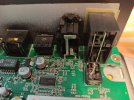Got a NAD CS1 set up here.
Works nicely via Eth or Wifi with Android/BubbleUPnP or Windows/foobar which play my (44.1, 48, 88.2, 96, 192 16/24) FLAC content flawlessly (no drop outs, gapless, 24bit deep with swift & quick operation, just like an USB-DAC). Bubble and foobar play through WAV conversion (FFmpeg/AudioCast off and foo_out_upnp).
2 things to moan about:
There is a silly unsecured WiFi node built in, blasting the NAD´s presence to anybody around. Worst is, if one knows the set mgmt IP address (it has a built-in web server) a foreign person may screw up the whole thing, including false or destructive SW update w/o any password protection.
- If anybody knows how to silence that, I would be grateful to learn how (I am attempted to turn off that WiFi manually, since I solely use Eth anyway)!
Electrically, the analog and the SPDIF outputs share the same ground, which is probably also a reason for the poor built-in DAC measurements, Amir has documented.
They ommitted the (mandatory) SPDIF output transformer isolation. So, not relying solely on my RME ADI-2 fs to isolate any EMI via SPDIF, I decided to use Toslink...

